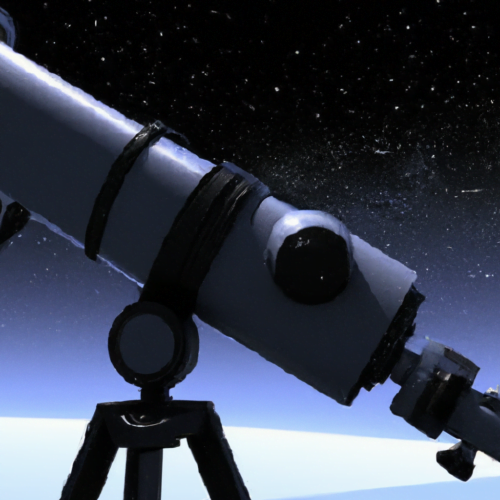Imagine looking through the eyepiece of a telescope and being transported to another world, where the wonders of the universe unfold before your eyes. But have you ever wondered how the field of view of that eyepiece can affect your observations? In this article, we will explore the intriguing relationship between an eyepiece’s field of view and the impact it has on your observations. From the vastness of the night sky to the intricate details of celestial objects, get ready to uncover the secrets hidden within an eyepiece’s field of view.
Table of Contents
Eyepieces and Field of View
Understanding the basics of eyepieces
Eyepieces are the components of a telescope that allow you to view distant objects with magnification. They play a crucial role in determining the field of view, which refers to the amount of sky or scenery visible through the eyepiece at any given time. Understanding the basics of eyepieces is essential for making informed decisions about which ones to use for different observing scenarios.
The concept of field of view
Field of view is the area of sky or the amount of scenery that is visible through the eyepiece. It is typically measured in degrees and can vary depending on the focal length of the eyepiece and the type of telescope used. A wider field of view enables you to see a larger portion of the sky or scenery, while a narrower field of view allows for more magnification but limits the amount of sky or scenery you can observe at once.
Types of Field of View
Apparent field of view
The apparent field of view refers to the apparent size of the field of view when looking through the eyepiece. It is determined by the design of the eyepiece and can vary greatly. Eyepieces with wider apparent fields of view provide a more immersive observing experience, allowing you to take in more of the sky or scenery. Common values for apparent field of view range from around 40 to 100 degrees.
True field of view
The true field of view is the actual size of the portion of the sky or scenery that is visible through the eyepiece. It takes into account the magnification provided by the eyepiece and the telescope. To calculate the true field of view, you need to know the apparent field of view of the eyepiece and the telescope’s focal length. A wider true field of view allows for a larger area of sky or scenery to be observed.

Eyepiece Design and Field of View
Eyepiece focal length and field of view
The focal length of the eyepiece plays a crucial role in determining the field of view. Generally, eyepieces with shorter focal lengths provide wider fields of view, while those with longer focal lengths offer narrower fields of view. However, other factors, such as the design of the eyepiece, can also influence the field of view. It’s important to choose an eyepiece with an appropriate focal length for the intended observing targets and desired field of view.
Eyepiece construction and field of view
The construction of an eyepiece can also impact the field of view. Wide-angle eyepieces utilize complex optical designs to achieve wider fields of view. They often incorporate multiple lenses and advanced coatings to minimize aberrations and increase the clarity of the image. These eyepieces offer a more immersive observing experience, allowing you to explore the night sky or observe landscapes with a greater sense of depth.
Impact of Field of View on Observations
Enhancing the viewing experience
A wider field of view can greatly enhance the viewing experience. It provides a broader perspective and allows for more context when observing celestial objects or exploring landscapes. With a wider field of view, you can appreciate the surrounding environment and gain a better understanding of the object you are observing. It also reduces the need for constant repositioning of the telescope or your eyes, offering a more relaxed and enjoyable observing session.
Ability to observe larger objects
A larger field of view is especially beneficial when observing larger celestial objects, such as star clusters or nebulae. These objects often span a wide area in the sky and require a wider field of view to be fully appreciated. A narrow field of view would limit your ability to observe the entire object at once and may require panning or multiple observations to capture the full extent. A wider field of view allows you to observe these objects in their entirety, revealing their intricate details and structures.
Spatial awareness and navigation
Field of view is crucial for maintaining spatial awareness and navigating the night sky or landscapes. A wider field of view allows you to easily locate and identify objects, as it provides a larger reference frame. It enables you to recognize patterns, identify constellations, and easily move from one object to another. This spatial awareness is particularly important for astronomers and nature enthusiasts who rely on accurate navigation to explore and study the night sky or observe wildlife in their natural habitats.

Field of View and Astronomical Observations
Exploring deep sky objects
When observing deep sky objects, such as galaxies and nebulae, a wider field of view is often preferred. These objects are typically faint and spread out over a larger area in the sky. With a wider field of view, you can view these objects in the context of their surroundings, capturing their intricate structures and interactions with neighboring celestial bodies. It allows for a more immersive experience, providing a deeper understanding of the vastness of the universe.
Studying wide star fields
Wide star fields, such as open star clusters or the Milky Way, require a wider field of view to capture the full beauty and complexity of the scene. These objects span a significant portion of the sky and can be best appreciated with a wider field of view. It allows you to observe numerous stars at once, discern patterns and formations, and grasp the three-dimensional nature of the celestial objects. A wider field of view is essential for studying the composition and dynamics of these vast stellar landscapes.
Observing planets and the moon
For observing planets and the moon, a narrower field of view is often desirable. Planetary objects are relatively small and require higher magnifications to reveal details on their surfaces. A narrower field of view provides greater magnification, allowing you to observe fine features such as crater formations, cloud bands, or the intricate rings of Saturn. Focusing on a smaller area of the sky helps to maximize the available detail and clarity, enhancing your ability to study the celestial bodies.
Choosing the Right Field of View
Consideration of observing targets
When choosing an eyepiece, it is important to consider the observing targets and the desired field of view. If you are primarily interested in viewing deep sky objects or wide star fields, opting for eyepieces with wider fields of view would be beneficial. On the other hand, if planetary observations are your main focus, narrower fields of view will allow for higher magnifications and better detail. Understanding your observing preferences and the nature of the objects you want to observe will guide you in selecting the appropriate field of view.
Matching field of view to telescope
To optimize your observing experience, it is crucial to match the field of view of the eyepiece with the capabilities of your telescope. Telescopes have different focal lengths and aperture sizes, which influence the potential field of view achievable. Eyepieces with shorter focal lengths are better suited for telescopes with longer focal lengths, as they provide wider fields of view. Conversely, telescopes with shorter focal lengths may require eyepieces with longer focal lengths to achieve a narrower field of view. Matching the field of view ensures that you maximize the potential of your telescope and eyepiece combination.
Balancing magnification and field of view
It is important to find a balance between magnification and field of view to suit your observing preferences. Higher magnifications allow for more detailed observations, but they also result in a narrower field of view. Lower magnifications provide wider fields of view but may sacrifice fine details. Depending on your observing goals and preferences, you may need to experiment with different eyepiece focal lengths and magnifications to find the optimal balance between magnification and field of view for your observations.

Eyepiece Accessories to Optimize Field of View
Use of focal reducers and Barlow lenses
To further optimize the field of view, you can utilize focal reducers or Barlow lenses. Focal reducers increase the field of view by reducing the focal length of the telescope, resulting in wider fields of view for a given eyepiece. This can be particularly beneficial when observing deep sky objects or wide star fields, providing a more encompassing view. On the other hand, Barlow lenses increase the focal length, offering larger magnifications and narrower fields of view. These accessories can be used in conjunction with different eyepieces to fine-tune the field of view according to your observing needs.
Eyepiece filters and field of view
Eyepiece filters can also impact the field of view, although to a lesser extent than focal reducers or Barlow lenses. Filters, such as a moon filter or light pollution filter, can alter the contrast and brightness of the observed objects but do not fundamentally change the field of view. However, they can enhance the overall observing experience by reducing glare or enhancing specific features, allowing for a better appreciation of the field of view.
Field of View and Terrestrial Observations
Observing wildlife and landscapes
While field of view is often associated with astronomical observations, it is also important for terrestrial observations. Whether you are observing wildlife or landscapes, a wider field of view provides a broader perspective and allows you to capture more detail in a single glance. It is particularly useful for observing fast-moving objects or capturing panoramic views of expansive scenery. When engaging in terrestrial observations, choosing eyepieces with wider fields of view can greatly enhance your ability to appreciate the natural world.
Spotting scopes and field of view
Spotting scopes, which are primarily designed for terrestrial observations, often prioritize wider fields of view. They are commonly used for birdwatching, nature observation, or surveillance. Spotting scopes with wider fields of view enable you to quickly locate and track objects, ensuring that you do not miss any important details or movements. When engaging in terrestrial observations, considering the field of view of your spotting scope is essential for maximizing your observational experience.

Practical Tips for Maximizing Field of View
Proper eyepiece cleaning and maintenance
To ensure optimal field of view, it is important to properly clean and maintain your eyepieces. Dust, fingerprints, or smudges on the lenses can degrade the image quality and reduce the effectiveness of the field of view. Cleaning the lenses with a soft cloth or lens cleaning solution specifically designed for optical equipment is recommended. Regular maintenance, such as storing the eyepieces in a clean and dry environment, can also help preserve their optical performance and prolong their lifespan.
Positioning and alignment for optimal field of view
To maximize the field of view during observations, it is important to position and align yourself correctly. Adjusting the eyepiece height and angle to match your eye level ensures a comfortable viewing experience while maintaining an unobstructed field of view. Properly aligning your telescope to the object of interest or aligning your spotting scope to the desired area for terrestrial observations will help optimize the field of view. Taking the time to position and align yourself properly guarantees that you can fully appreciate the wider field of view and make the most of your observing sessions.
Limitations and Considerations
Effects of atmospheric conditions on field of view
The field of view can be influenced by atmospheric conditions, particularly when observing astronomical objects. Factors such as light pollution, air turbulence, or high humidity can result in reduced clarity and visibility, limiting the effective field of view. Light pollution filters can mitigate the effects of light pollution, improving the contrast and enhancing the overall field of view. However, atmospheric conditions are beyond our control, and it is important to be aware of their potential impact on the field of view during observations.
Optical aberrations and field of view distortions
Optical aberrations can also affect the field of view, resulting in distortions or imperfections in the observed image. Common aberrations include chromatic aberration, spherical aberration, and astigmatism. These aberrations can introduce blurring, color fringing, or distorted shapes, diminishing the overall quality of the field of view. Choosing high-quality eyepieces with advanced optical designs and coatings can help minimize these aberrations, ensuring a clearer and more accurate field of view. However, it is important to note that even the best eyepieces may still exhibit minor aberrations that can affect the field of view to some extent.
In conclusion, the field of view of an eyepiece plays a critical role in observational experiences, whether in the realm of astronomy or terrestrial observations. Understanding how different factors, such as eyepiece design, focal length, and accessories, influence the field of view allows for informed decisions when selecting the appropriate eyepiece for specific observing scenarios. By optimizing the field of view, you can maximize your ability to explore and appreciate the wonders of the night sky or the beauty of the natural world around you.

